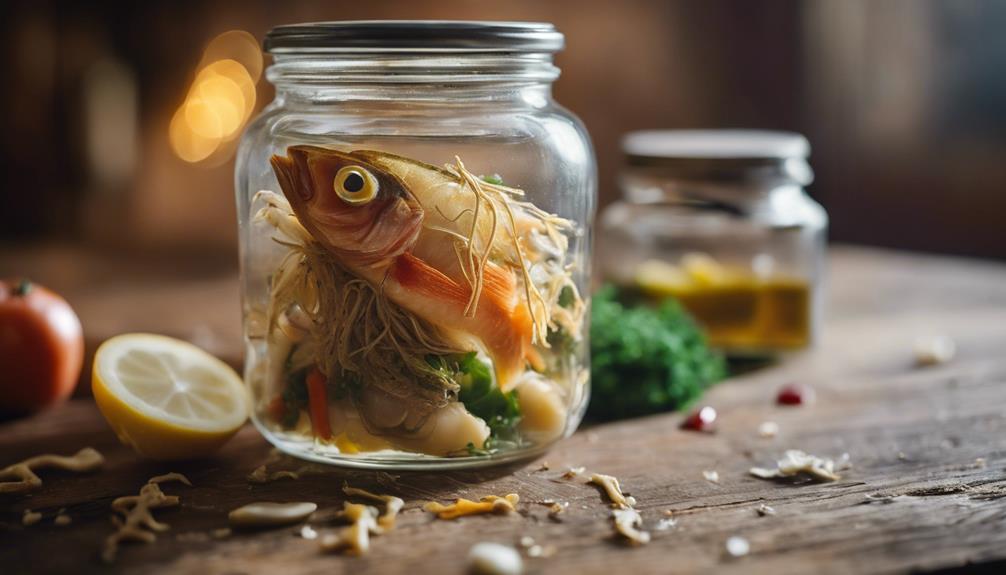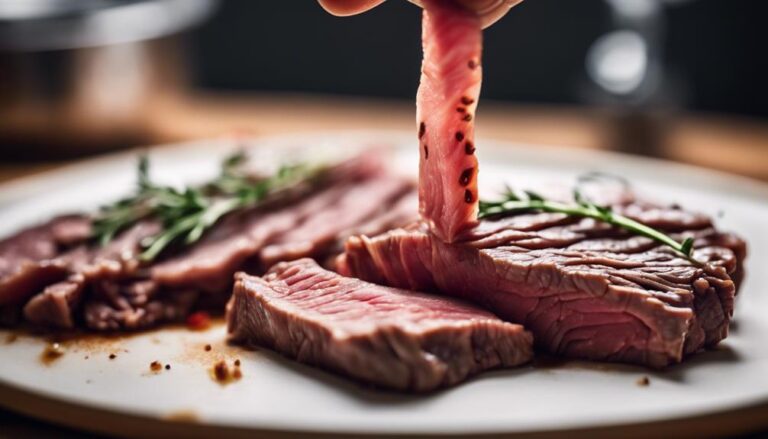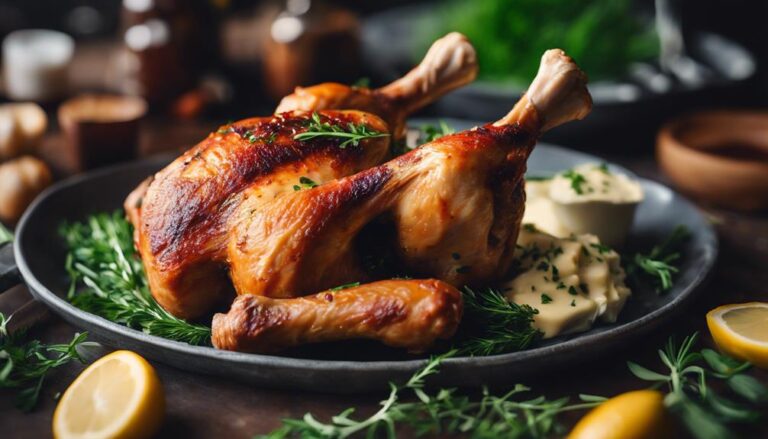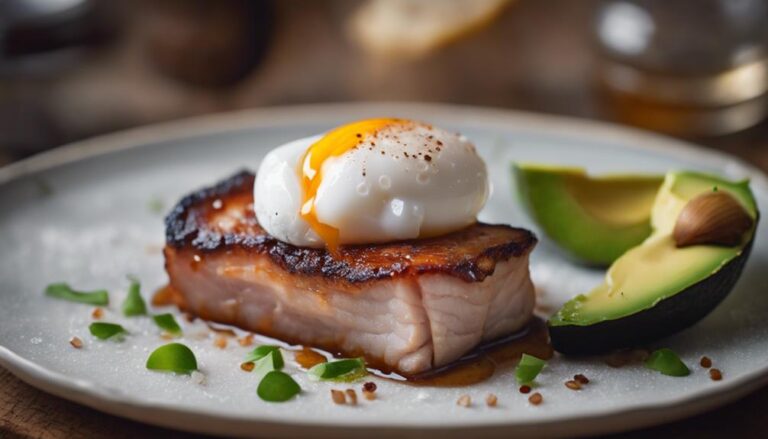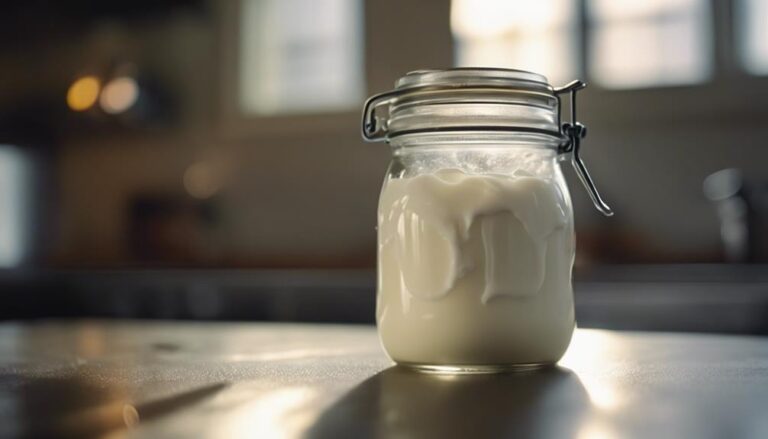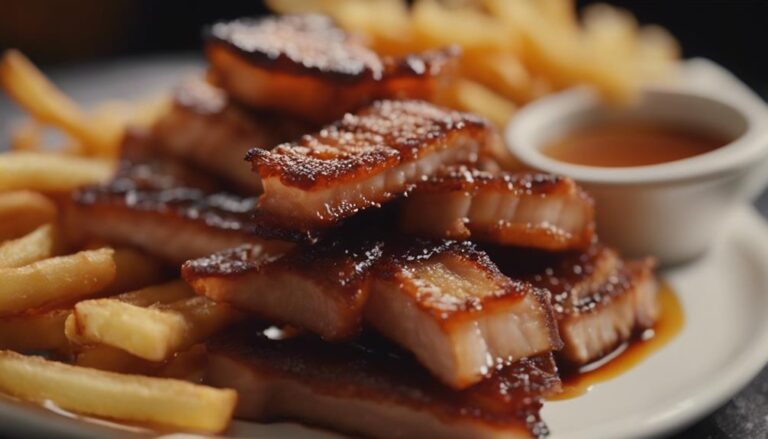Sous Vide Fish Stock: Rich and Nutrient-Dense
Experience the richness and nutrient density of sous vide fish stock. By precisely controlling temperatures, this method guarantees maximum flavor extraction and nutrient retention. The result is a stock that is not only flavorful but also packed with essential nutrients. Discover the elevated dining experience that sous vide fish stock can bring to your dishes.
What You Will Learn Here
- Sous vide fish stock retains rich flavors and nutrients due to controlled temperature.
- Precise sous vide cooking extracts maximum nutrients for a nutrient-dense stock.
- Slow cooking in sous vide enhances gelatin extraction for a flavorful and nutritious base.
- Temperature control in sous vide ensures optimal nutrient retention in fish stock.
- Sous vide method maintains fish stock clarity and intense flavors for culinary richness.
Origin of Sous Vide
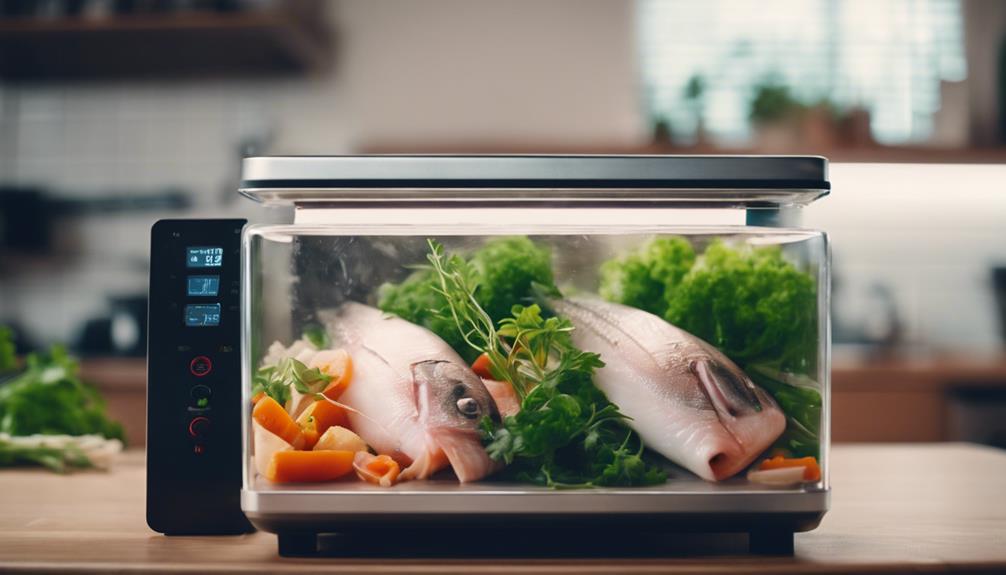
Sous vide cooking originated in the 1970s, credited to French chefs seeking precise and consistent cooking techniques. This method involves cooking food in vacuum-sealed bags at controlled temperatures for extended periods, resulting in precise outcomes.
The history of sous vide showcases culinary innovation and the evolution of cooking techniques in professional and home kitchens.
Sous Vide History
The inception of sous vide cooking can be attributed to French chefs Georges Pralus and Bruno Goussault in the 1970s. Cooking sous vide involves sealing ingredients in a vacuum-sealed bag and cooking them at precise temperatures in a water bath for an extended period.
The term 'sous vide' translates to 'under vacuum' in French, highlighting the method's use of vacuum-sealed bags. Initially utilized in commercial kitchens for its consistency and precision, sous vide cooking eventually gained popularity in home kitchens.
This technique helps retain the natural flavors, nutrients, and textures of the ingredients, resulting in high-quality dishes. The history of sous vide showcases a method that revolutionized cooking by offering a precise and controlled way to prepare food.
Cooking Technique Evolution
The evolution of cooking techniques, particularly the origin of sous vide, can be traced back to the innovative methods utilized by French chefs as early as the 18th century. French chefs experimented with vacuum-sealed containers to cook food in water baths, laying the foundation for modern sous vide.
The technique gained prominence in the 1970s when Georges Pralus pioneered the modern sous vide method. Initially used for cooking meats, sous vide has since expanded to various applications, including plant-based sous vide dishes, sous vide desserts that retain delicate textures, and even sous vide cocktails that infuse flavors precisely.
This evolution has revolutionized culinary practices by preserving flavors, textures, and nutrients in a precise and controlled manner, appealing to those seeking a meticulous approach to cooking.
Culinary Innovation Origins
Originating in the culinary landscape of France in the 1970s, the innovative cooking technique known as sous vide revolutionized the way food was prepared and enjoyed. Initially developed by Chef Georges Pralus for cooking foie gras, sous vide, meaning 'under vacuum' in French, involves vacuum-sealing ingredients in plastic pouches and cooking them in a precisely controlled water bath.
While sous vide meatballs, desserts, and cocktails weren't the initial applications, the method's popularity soared in fine dining for its accuracy in temperature control and flavor preservation. This technique's evolution has made it a staple in home kitchens, offering convenience and consistent results. The origins of sous vide have paved the way for culinary creativity and precision in various dishes beyond its original purpose.
Sous Vide Fish Marinade
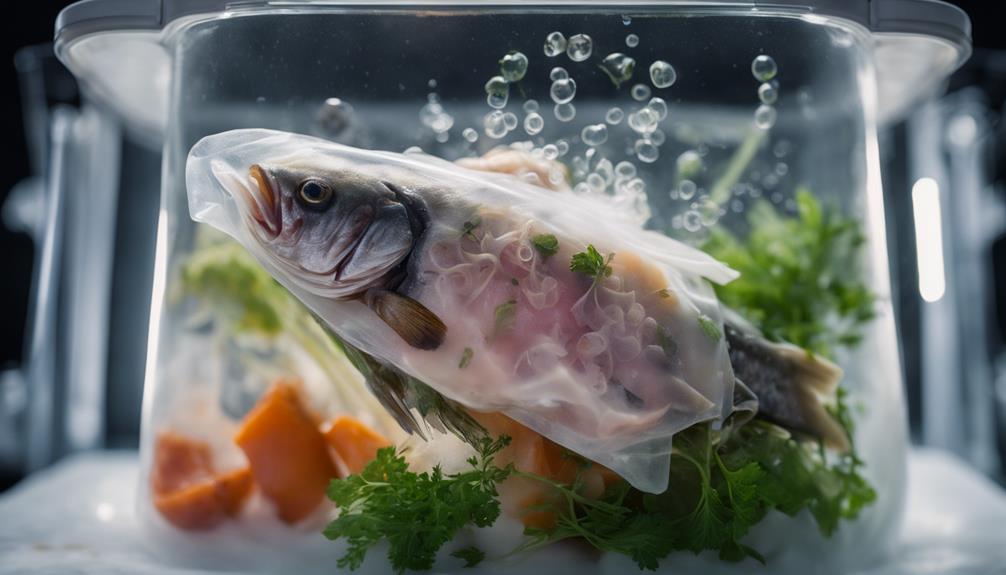
Enhance the flavors and textures of your sous vide fish by utilizing a well-crafted marinade. Marinating fish before sous vide cooking is an essential step that can greatly impact the final dish. Here are some key points to keep in mind when creating a marinade for your sous vide fish:
- Enhanced Tenderness: Marinating fish allows the acidic components in the marinade to break down proteins, resulting in a more tender and succulent texture.
- Flavor Infusion: By marinating fish for at least 30 minutes before sous vide cooking, you give the ingredients in the marinade time to penetrate the fish, infusing it with a depth of flavor.
- Texture Improvement: Ingredients like herbs, spices, oils, and citrus can be used to enhance the texture of the fish, creating a more complex and enjoyable eating experience.
Sous Vide Fish Fillet
When preparing Sous Vide Fish Fillet, consider the various dishes you can create such as Sous Vide Fish Tacos, Smoked Sous Vide Fish, and Fish Ceviche Sous Vide.
These options showcase the versatility of sous vide cooking techniques for fish fillets.
Experimenting with different recipes can help you discover new ways to elevate the flavors and textures of your fish dishes.
Sous Vide Fish Tacos
For best results when preparing sous vide fish tacos, guarantee precise seasoning and cooking of the fish fillet to achieve a juicy and flavorful taco filling. When crafting these delectable tacos, consider the following:
- Flavorful Toppings: Elevate your tacos with fresh ingredients like avocado slices, pickled onions, or a zesty mango salsa to complement the delicate fish flavors.
- Crunchy Shells: Opt for crispy corn tortillas or lightly fried shells to provide a satisfying crunch that contrasts with the tender fish.
- Creative Presentations: Experiment with different plating styles to make your sous vide fish tacos visually appealing, whether served on a rustic wooden board or arranged elegantly on a plate.
Smoked Sous Vide Fish
To impart a rich, smoky flavor to your fish fillets for sous vide cooking, consider incorporating a smoking step before immersing them in the sous vide water bath. This method enhances the depth of flavor and guarantees the fish is evenly infused with smoky notes throughout the cooking process. Here are some key points to keep in mind for smoked sous vide fish fillets:
- Smoked Infusion: Smoking the fish fillets before sous vide cooking adds a rich, smoky flavor to the final dish.
- Flavorful Cooking: Combining smoking and sous vide cooking results in a dish with a more robust flavor profile.
- Nutrient Packed Option: Smoked sous vide fish fillets aren't only flavorful but also nutrient-dense, providing essential proteins and omega-3 fatty acids.
Fish Ceviche Sous Vide
Enhancing the traditional ceviche method, sous vide fish fillet preparation involves precise temperature control for safe 'cooking' while maintaining the delicate texture and flavors of the fish. When making fish ceviche sous vide, consider these key points:
- Traditional preparation, modern twist: Sous vide adds a contemporary touch to the classic ceviche technique by ensuring controlled temperature throughout the cooking process.
- Flavorful customization, unique taste: Marinating the fish in citrus juices and seasonings in a sous vide pouch allows for personalized flavors with the addition of herbs, spices, and vegetables.
- Safe 'cooking', delicate texture: The sous vide method guarantees that the fish is safely 'cooked' while preserving its tender texture, resulting in a dish that's both safe and delicious.
Sous Vide Temperature Control
When utilizing sous vide for fish stock, precise temperature control is essential for best results. Consistent cooking at a controlled temperature guarantees that the flavors and nutrients are extracted effectively.
This method enhances flavor retention and helps create a nutrient-dense stock that can enhance your culinary dishes.
Precise Temperature Control
In addition, for precise temperature control in sous vide cooking, it's essential to maintain a consistent and accurate temperature within a narrow range to optimize the extraction of flavors from fish bones and aromatics. Sous vide allows for temperature accuracy within a fraction of a degree, facilitating the ideal conditions for flavor extraction.
This controlled cooking environment also promotes gelatin formation and nutrient preservation from fish bones, resulting in a rich and nutrient-dense fish stock. By cooking at lower temperatures over an extended period, collagen breakdown enhances the stock's flavor profile and texture.
Additionally, sous vide prevents evaporation, leading to a more concentrated and flavorful fish stock than traditional methods. Moreover, the convenience benefits of sous vide include easy portioning, storage, and reheating without compromising quality.
Consistent Cooking Results
To consistently achieve ideal cooking results in sous vide fish stock preparation, maintaining precise temperature control is crucial for maximizing flavor extraction and nutrient retention. The table below illustrates the importance of maintaining a constant temperature throughout the sous vide cooking process for consistent and best outcomes.
| Temperature Control | Result |
|---|---|
| Precise and constant temperature | Maximizes flavor extraction |
| Consistent heat distribution | Guarantees uniform nutrient preservation |
| Prevents fluctuations | Results in reliable and repeatable cooking outcomes |
Enhanced Flavor Retention
Enhanced flavor retention in sous vide fish stock preparation is greatly influenced by the precise temperature control facilitated by this cooking method. Sous vide cooking allows for consistent and controlled temperatures, optimizing the extraction of flavors and nutrients from the ingredients.
This process enhances the preservation of delicate fish stock flavors and guarantees that essential nutrients are retained in the final broth. By maintaining a stable temperature, sous vide minimizes the risk of flavor loss due to overcooking or evaporation, resulting in a more aromatic and robust fish stock.
The controlled environment of sous vide cooking ensures that all the intricate flavors and nutrients of the fish stock ingredients are preserved, culminating in a highly flavorful and nutrient-dense end product.
Final Thoughts
In your assessment of sous vide fish stock, consider the unparalleled depth of flavor and nutritional benefits this method offers. Sous vide cooking allows for maximum nutrient extraction and flavor retention from fish bones and aromatics, resulting in a stock with a rich gelatin content and a clear, clean taste.
The controlled cooking temperature of sous vide guarantees that the stock maintains its gelatin content while delivering consistent results each time you prepare it. This precision in cooking temperature leads to a final product that's more intense and flavorful compared to traditional stock-making methods.
Frequently Asked Questions
Can You Leave Fish in Sous Vide Too Long?
You can leave fish in sous vide too long, risking a mushy texture and loss of flavor. Follow recommended cooking times to avoid sous vide dangers like excessive protein denaturation. Monitor closely for fish safety and best results.
What Is the Best Fish for Sous Vide?
When it comes to sous vide cooking, Sous Vide Salmon offers a rich, flavorful experience. Sous Vide Halibut provides a tender, delicate texture, while Sous Vide Cod offers a firm, lean profile. Each fish excels with precise temperature control, ensuring ideal results.
Is Sous Vide Healthier Than Steaming?
When comparing sous vide and steaming, you'll find that sous vide offers exceptional nutritional benefits by preserving more nutrients through precise cooking techniques. Plus, it caters to taste preferences with flavorful outcomes and healthier meal options.
Is Sous Vide Fish Worth It?
Sous vide fish stock is definitely worth it for you. It maximizes flavor and nutrients through precise temperature control. Enjoy the benefits of enhanced extraction, consistent results, and nutrient density with this cooking technique.
Conclusion
To sum up, sous vide fish stock offers a rich and nutrient-dense option for culinary enthusiasts looking to elevate their dishes. By utilizing precise temperature control and a carefully crafted marinade, this cooking method produces a flavorful and tender fish fillet.
The origin of sous vide cooking adds a historical and innovative touch to this modern culinary technique. Overall, sous vide fish stock is a must-try for those seeking a delicious and nutritious dining experience.
